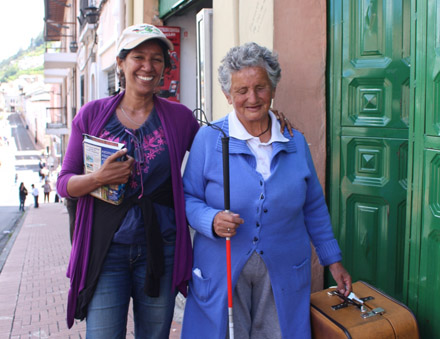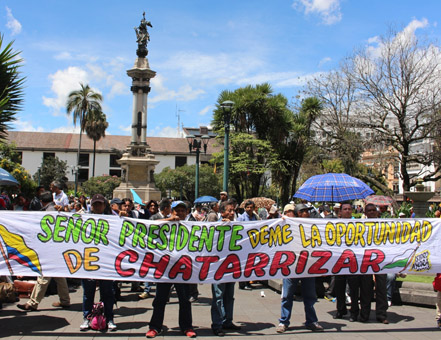
Shuffling slowly through the street, the old lady carries a heavy suitcase and a small stool in her hand. She is blind and carefully examines the ground with her long stick before making the next step. Being awed by the dazzlingly golden churches, cobble stone lanes and 17th century facades of Quito's old town, we haven't noticed her until we suddenly hear her whisper next to us asking whether someone could help her cross the road ahead. This is how we meet Laura.
Laura is 78 years old and lives two hours outside Quito, the capital of Ecuador. Her small pension is not enough for her to survive and in spite of being blind, she commutes every day to the town center to play her accordion on the main square. Just now, she is heading for lunch a couple of blocks away. Zayra holds her hand to help her across the busy streets. The years of her life show in the lines of Laura's face and she appears frail. Yet, as I carry the suitcase which contains her accordion, I feel like I am holding a box of lead. How on earth is Laura able to carry this every day at her age and how does she feel having to brave the mayhem of Quito without seeing anything? Yet, Laura radiates an admirable grace and for me stands as a metaphor for Ecuadorians – a nation that has gone through a lot of turmoil and yet exudes a delightfully welcoming cheerfulness.
"Ama la Vida" – Love Life: this is the slogan with which Ecuador markets itself as a tourist destination. And Ecuadorians really live up to this motto. Not since Iran have I met people approaching us with such openness and curiosity. Wherever we stop on our way, we are soon surrounded by kids and grown-ups who ask us about where we come from and where we are going and what all these flags are about??? Sooner or later, they all say "Bienvenido a Ecuador!" – Welcome to Ecuador! This is expressed so joyfully that it indeed makes us feel welcome in this beautiful country which like Kenya straddles the equator.
Until 2006, Ecuador was a prototypical banana republic and an economic basket case, weighed down by poverty, inequality and political turmoil. Since its independence in 1830, Ecuador has gone through more than 80 changes in government and 20 constitutions! Over the last decade, however, Ecuador has seen momentous development, with huge investments in education, health care and infrastructure. Primary & secondary school as well as health care are free, and the quality of both education and health care are praised by everyone we talk to. Over the past 8 years, 6000km of roads have been built or repaired, and Ecuador has by far the best roads we have so far experienced in Latin America.
How has Ecuador achieved this? For Kenyan leaders, it might be worthwhile having a look at Ecuador, as example on how to turn the wealth from natural resources into economic growth and improving living standards of the entire population. Learning from Ecuador would be particularly relevant for Kenya due to the recent discovery of oil reserves.
Ecuador is well endowed with oil, but until Rafael Correa took over the presidency in 2006, much of the wealth from Ecuador's reserves flowed out of the country. A new law changed this in 2010 and significantly increased Ecuador's share of oil revenues. Equally important, Correa has managed to reduce corruption and turn the oil revenues into high quality services for citizens. Furthermore, he has embarked on a radical wealth redistribution plan. The poorest of the poor receive a monthly stipend and a specific program supports 300,000 disabled people. Taxation aims at supporting the poor and middle class while targeting the rich. For example, luxury cars are subject to a 5-10 times higher tax rate than low-cost vehicles.
As a result, Ecuadorians are the first people we meet on our entire journey who actually are happy with their president and government. This is a stark contrast with other countries, especially with Colombia where nobody we talked to had anything positive to say about their politicians. A day after we have met Laura, we vividly observe President Correa's popularity. On Quito's main square, we witness the weekly "Changing of the Guards" ritual attended by a huge crowd. The president graces the occasion from the balcony of the Government Palace and receives rousing cheers. We are surprised when we realize that there are no security checks at all. People in the square are holding placards with personal messages and petitions for the president – they seem to have faith in him and the police demonstrate tolerance even towards critical messages.
 Three days ago, we experienced a similar demonstration of tolerance in Popayan, our last stop in Columbia. This charming colonial city has won our hearts with its energy and spirit. Walking around town at night, we stand transfixed as we watch young break dancers contort their bodies with graceful movements into impossible shapes. Heading in the direction of ear splitting live music, we reach a plaza where Popayan's vibrant student population is gyrating to popular Latino tunes belted out by promising young musicians. The atmosphere is electrifying and before we know it, Saturday night fever has caught on and we are part of the partying crowd, with our travel companion Fernando letting loose his Brazilian charm and dazzling every Colombian woman in sight.
Three days ago, we experienced a similar demonstration of tolerance in Popayan, our last stop in Columbia. This charming colonial city has won our hearts with its energy and spirit. Walking around town at night, we stand transfixed as we watch young break dancers contort their bodies with graceful movements into impossible shapes. Heading in the direction of ear splitting live music, we reach a plaza where Popayan's vibrant student population is gyrating to popular Latino tunes belted out by promising young musicians. The atmosphere is electrifying and before we know it, Saturday night fever has caught on and we are part of the partying crowd, with our travel companion Fernando letting loose his Brazilian charm and dazzling every Colombian woman in sight.
A little further on Popayan's main square, gigantic posters of Pope John Paul and Pope Francis are hanging from the Cathedral towers, strikingly embodying the power of the Catholic Church in Latin America. As we pass the square on our way home, candles are being lit and a large crowd is gathering. A poster reads "No to homophobia". Curious, we ask one of the police men standing guard what is happening here. He tells us that this event aims to challenge harassment and discrimination of gay people. Soon after, a couple of transgender queens arrive and in a symbolic gesture exchange the lit candles with the police men who have positioned themselves in a long line. We feel touched by this display of tolerance. A moment later, the gay queens turn the square into a cat walk and a colorful gay parade, to the enthusiastic applause of the crowd - and under the eyes of Pope John Paul and Pope Francis who benignly look on at the scene.

